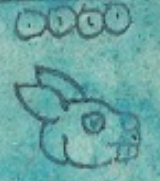Nahui Tochtli (Mdz2r)
This simplex glyph combined with a notation creates the solar year (xihuitl) date, Four Rabbit. The notation (four ones, nahui) are on the top and the rabbit head (tochtli) on the bottom. The notation for the number one (just like many multiples) is a circle with a smaller dot in the center. The rabbit's head is shown in profile, facing to the viewer's right. The one visible eye is open and teeth are protruding from the mouth. The entire date (including the background) is painted a turquoise color, which could serve as a phonetic indicator for the word year (xihuitl), since year and turquoise are homophones. While the image here does not show it, the date is enclosed in a square black-line drawing on the original manuscript.
Stephanie Wood
Four Rabbit was also a day sign. But in the context from which this glyph has been extracted, it refers to a year. The year 1524 was a Four Rabbit year, and this is when the "twelve" ("Los Doce") friars came to Mexico according to various sources.
Stephanie Wood
c. 1541, or by 1553 at the latest
Xitlali Torres
dates, fechas, ones, numbers, números, years, años, reeds, cañas, rabbits, conejos, animales, calendarios, xiuhpohualli, turquesa, xihuitl

nahui, four, https://nahuatl.wired-humanities.org/content/nahui
toch(tli), rabbit, a year name, https://nahuatl.wired-humanities.org/content/tochtli
Cuatro Conejo
Stephanie Wood
Codex Mendoza, folio 02 recto, https://digital.bodleian.ox.ac.uk/objects/2fea788e-2aa2-4f08-b6d9-648c00..., image 14 of 188.
The Bodleian Libraries, University of Oxford, hold the original manuscript, the MS. Arch. Selden. A. 1. This image is published here under the UK Creative Commons, “Attribution-NonCommercial-ShareAlike 3.0 License” (CC-BY-NC-SA 3.0).
